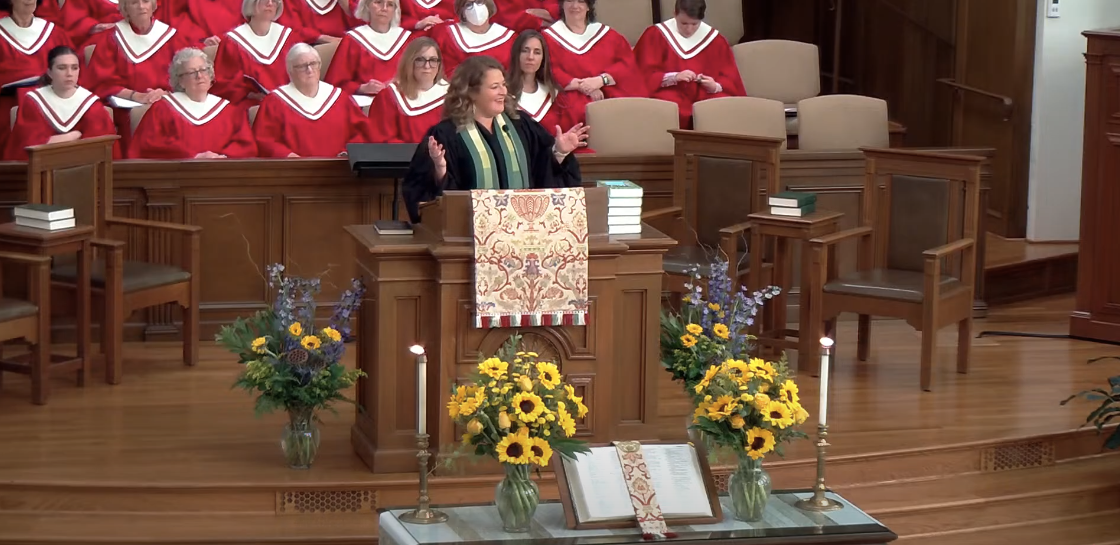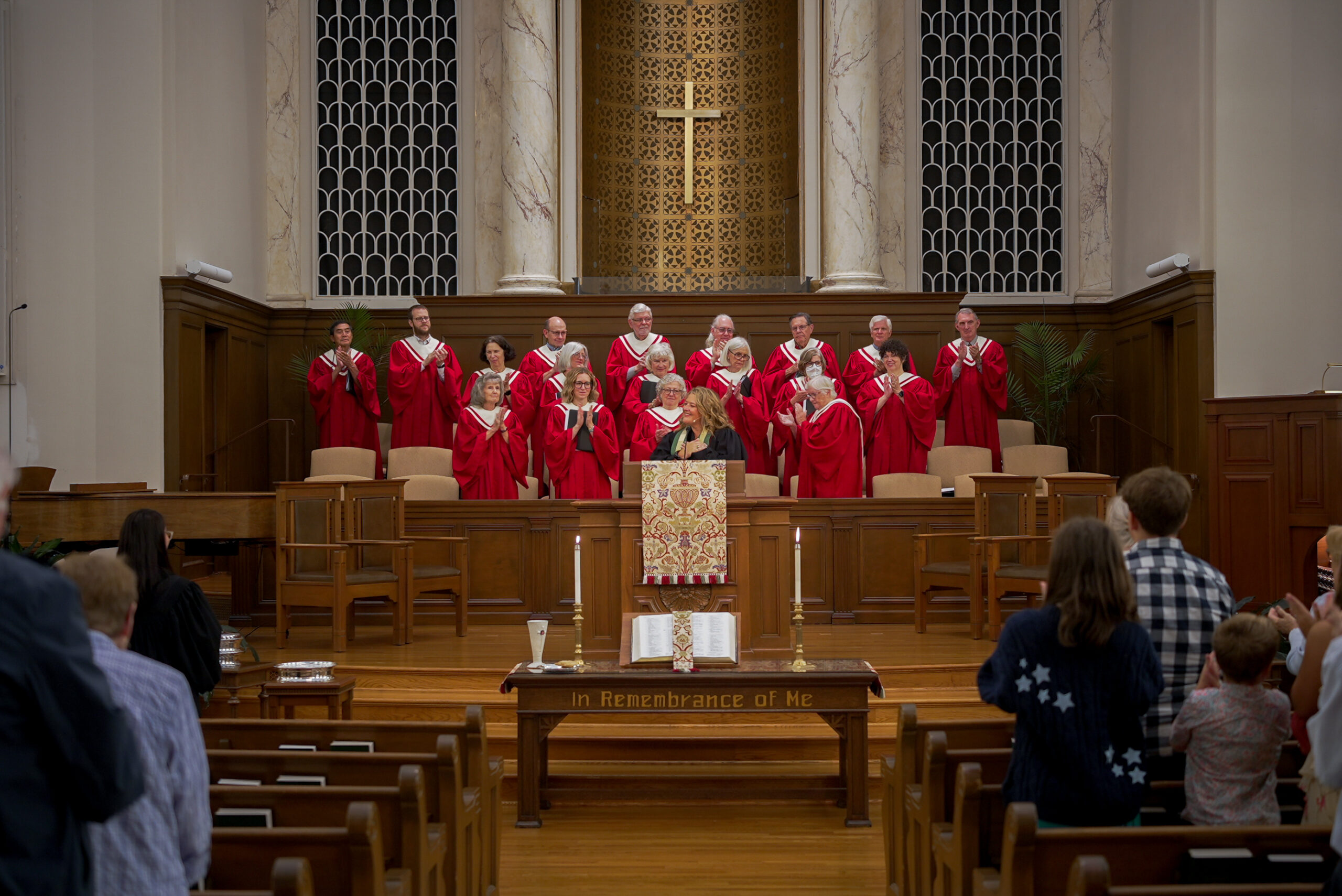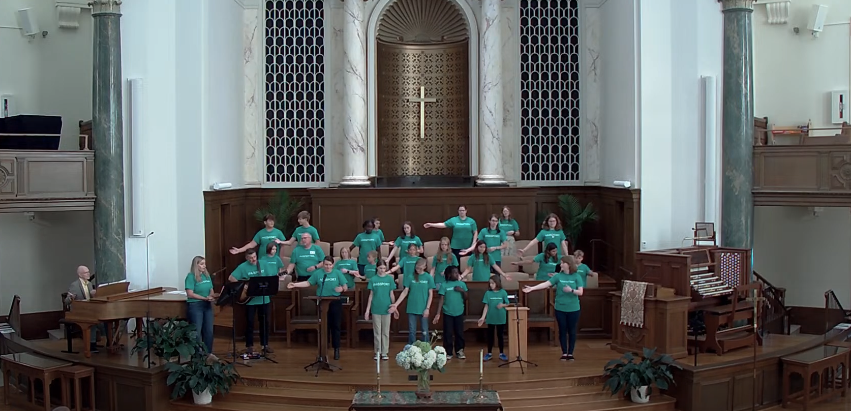I.Asking for a show of hands among the students in the room – how many of you are glad to be back to school? (Parents, I won’t ask you how many of you are glad your kids are back at school?) Students again – now tell me – how many of you had your first day of school outfit picked out before you started?
There’s just something about the first day of school outfit, isn’t there? For lots of students, it represents the thought (or lack thereof) given to the vibe they want to set as the year begins, the things that hold their interest, the identity they want to cultivate and share, the look for their ever-evolving self. Clothing does that, doesn’t it? It communicates to self and others about the state of our being underneath, like how a group of people clad in all-black might indicate that they are mourning the loss of a loved one. Clothing defines, like a group in scrubs who are likely medical professionals, or those in orange jumpsuits who are likely incarcerated. Clothing unites. In a couple of weeks, we’ll pull out our black and gold, or Carolina blue and navy, or orange and white, or insert your favorite college’s colors here, and become fans, together. Clothing can heighten distinctions or collapse them, give comfort in anonymity or vibrancy in particularity. And all you have to do is just put it on.
But it’s not just clothing we try on for identity’s sake. In his massively popular book, Atomic Habits, author James Clear has taught millions of us how to try on habits like they’re a kicky jacket or a fresh pair of shoes. “Every action you take is a vote for the type of person you wish to become,” he famously says. “No single instance will transform your beliefs, but as the votes build up, so does the evidence of your new identity.”1 Meaning: habits form identity. So if you want to be the kind of person who gets up early to write in their journal, get up early to write in your journal. If you want to be the kind of person who bakes, get out your flour and bake! (And bring it to the church house if you need someone to try it!) In the realm of habit science, these small choices give you the chance to try on new identities and, repeated consistently over time, transform you into the kind of person you desire to be.
II.It’s right there between clothes and habits that we begin our conversation today. With a few stops and starts, we’ve spent these late summer weeks in the biblical letter called Colossians, where Paul, or perhaps even a student of Paul writing in his style and manner, wrote to the group of Christians there in the valley. We remember that his letter to them wasn’t prompted by a conflict or the need for a warning, but rather was a kind of love letter to the church about Jesus: both the cosmic Christ, “firstborn of all creation … through whom God reconciled God’s self to all things,” and the human Jesus, the compassionate man who healed and served and transformed systems of power and status. The letter was written to remind this community of Christians to stay near to Jesus Christ, to remember the hope of his good news, to have eyes wide open to the distance between the harmful ways of the world and the loving ethics of the Christian life.
“So if you have been raised with Christ,” our passage begins, speaking of the baptism these Christians had experienced, “seek the things that are above where Christ is…. Therefore as God’s chosen ones, holy and beloved, clothe yourselves with compassion, kindness, humility, meekness, and patience… above all, clothe yourselves with love, which binds everything together in perfect harmony.”
I imagine that as these early Christians heard these words, they’d remember their baptism – the white tunic they would have worn, symbolizing the new life they’d found in Jesus. But before they put on these new clothes, the writer said, they needed to take off the old. Take off the malice. Shed the misconduct. Remove the gossip. Discard the anger. Divest yourself of the greed. Strip away the idolatry. Why? Because you’ve been raised with Christ! You have found newness of life in the one who promises life to the full. In Christ, the old distinctions that divide and separate human from human give way to the new community that Jesus Christ has already created.
All throughout Colossians, this has been the writer’s encouragement to those first Christians. Be fully alive like Christ. Let go of the exploitation, the retribution, the violence, the systems of this world that cause us to forget who and whose we are. Instead, put on Christ. Clothe yourselves with the new self you’ve found in him. Do so with a stitch of kindness. A thread of humility. A dart of meekness. A pleat of patience. And then bind it all with love. These are our work clothes, or to put it more precisely, our work of Love clothes, the uniforms of the Christian life.
Why? Because that’s how Jesus lived, and we want to live like Jesus. “If we want to be Christian,” wrote Dietrich Bonhoeffer, some ten years after Hitler’s rise to power, “if we want to be Christian, we must share in Christ’s large-heartedness . . . his liberating love for all who suffer.”2 Compassion is another word for it, as Colossians says, the sort of churn in your gut for another. I love Frederick Buechner’s definition of compassion as “the sometimes fatal capacity for feeling what it’s like to live inside somebody else’s skin.”3 Living inside the skin of another clothes us in a whole new imagination of their lives, and holding the capacity to change us and them along the way.
III.On the last weekend before school started, our family squeezed in one final road trip to Knoxville for a few days with the McGee side of our family – the highlight of which had to be our Friday spent at Dollywood with Josh’s brother and his family. Oh we had the very best time: roaming the park, eating their world famous cinnamon bread, watching our kids take it in for the first time, and as you could tell last week, screaming a bit too loudly on all the roller coasters.
A lot has changed since I’d last been at Dollywood, but what remains unshakeably true is that Dolly Parton is one of this world’s greatest humans, and of that, I’m pretty certain we could all agree – no matter where you’re from, or who you love, or how you cast your vote. Beloved for her cheerful smile and gentle Southern voice, her down-home story and big heart for all people, Dolly communicated those values early on in her career, in part through one of her greatest hits, the song, “Coat of Many Colors.”
Written – appropriately! – on the back of a dry cleaning receipt, “Coat of Many Colors” speaks of Dolly’s upbringing in the rural hollers of East Tennessee. The Parton family lived in a one-room cabin – no electricity, no plumbing, no heat or air, but a whole lot of love. “I didn’t have a coat,” Dolly sings, “and it was way down in the fall. Momma sewed the rags together, sewin’ every piece with love, she made my coat of many colors, that I was so proud of.” As the song unfolds, Dolly tells how her mama wove together the threads of the biblical story with her own, connecting her to Joseph and his coat of many colors, and wishing that this thing she created to keep her daughter warm will become for her a gift of goodness and happiness. When Dolly wore that coat proudly to school, her classmates, well, they didn’t take the risk of stepping inside her skin. They made fun of her. “But they didn’t understand it,” she sings, “and I tried to make them see that one is only poor, only if they choose to be. Now I know we had no money, but I was rich as I could be in my coat of many colors, my momma made for me.”
Now I tell you – I’ve known and loved “Coat of Many Colors” for more than half my life, but it took on all new meaning to me last weekend. Because, you see, Dolly’s actual coat of many colors is on display in a newly-opened interactive museum that tells her story. I stood there for awhile to take it in, and was struck by how, well, ordinary it was. The stitches weren’t hidden, and one side of the coat was longer than the other. One sleeve was a bit scuffed up, and the collar was lopsided. It was small, nondescript, one you might pass right by. This coat has sold millions of records, inspired movies and children’s books, and is beloved the whole world over, and it’s just as Dolly said: rags and scraps sewn together with love.
I couldn’t help but to think of the clothes we put on as Christians, clothes of the spiritual sort, of course. They seem so ordinary – compassion and kindness, humility and meekness, patience and love. Nothing special, we might think. A scrap here, a rag there. Imperfect, just as we are. And yet, when stitched together, these marks of a Christian life become a garment that has the power to change a life, a family, a community, a people. We’re asked to put it on, day in and day out, even when we don’t feel like it, and thus over time, these clothes and the habits they represent form us in love. If “every action you take is a vote for the type of person you wish to become,” then every time you share compassion, every act of kindness, every time you practice humility, every gentleness, every choice to be patient despite every reason not too – each of these is a vote for the Christian life and the way of Jesus marked with love.
Clothing ourselves with compassion, kindness, meekness, humility, patience, and love isn’t just good for the people around us, but it’s good for us too, especially in these bitter, caustic times. Because clothing ourselves reminds us of who and whose we are. Practicing these simple ethics of the Christian life means we’re casting votes for the kind of person we want to be! So where there is cruelty, let us extend compassion. Where there is heartlessness, let us be kind. Where there is an oversized ego, let us be meek. Where there is pride, let us be humble. Where there is intolerance, let us be patient. Where there is indifference, let us show love. We do this for others, of course. We do this because of Jesus, most of all. But we do this so that the malice of this world doesn’t take root in the corners of our heart too.
During the 1950s, a man named A. J. Muste, long-time organizer and leader of the Fellowship of Reconciliation, stood outside the gate of a Strategic Air Command base alone holding a sign that read, “Ban the Bomb.” Each day he stood in silent vigil, all by himself. A reporter watched him, and after a week or so, approached Muste and said, “You know you’re not going to change anyone doing this.” To which Muste replied, “I know. But I can keep them from changing me.”4
IV.But when you might wonder – how could I possibly choose kindness when my boss is breathing down my neck or when my job might be on the line? How could I possibly be patient with my relatives who don’t share a single political value that I do? How could I possibly find compassion for the very people who have only extended to me indifference, contempt, and disgust? How could I possibly find my way to meekness and humility – won’t I get run over in this age of ego, arrogance, and hubris?
In these moments when we reach the limits of our imagination, I wonder if it helps to think that God is like Avie Lee Parton and the coat of many colors she made for her daughter. The same God who compassionately stitched together garments of skin for the first humans as they made their way out of Eden is the God who compassionately stitches together a garment of love for each of us. That when we only see rags, God sees the possibility of something far more than all we could ask or imagine. That when we think we can’t summon an ounce of love or kindness, “God clothes,” as Lauren Winner says. “God is our clothing. … God draws us into the act of clothing, by instructing us to clothe others. To do those things,” she says, “makes you a mimic of God, shap[ing] you more and more into God’s image.”5
I bet by now, all our students in the room aren’t laying their outfits out excitedly before they go to bed. Tomorrow’s a Monday after all, “just another Monday.” But tomorrow, when you pull on your clothes for another day, remember to wear love too. Do it again on Tuesday, and again on Wednesday, and the day after that, and the day after that, and don’t be surprised when you find yourself changed from the inside out. Amen!







